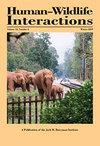Hunter Motivations and Use of Wild Pigs in Texas, USA
IF 0.9
4区 环境科学与生态学
Q4 BIODIVERSITY CONSERVATION
引用次数: 4
Abstract
Wild pigs (Sus scrofa) are a widespread exotic, invasive species that pose ecological, agricultural, and human health risks in their invaded range. Wildlife managers must manage wild pig abundance and range expansion to mitigate these risks. The diversity of stakeholders involved in the issue of wild pig management complicates efforts to manage the species, and, to be successful, wildlife professionals must consider the human dimensions associated with wild pig management. The prevalence of privately owned lands in Texas, USA necessitates cooperation to enact effective management policies. In this study, we investigate the impact of hunter motivations on wild pig harvest quantity. Motivations driving wild pig hunting are diverse. While the majority of wild pig hunters in Texas are motivated by trophy value, meat-motivated hunters harvest more wild pigs per day afield. Wildlife managers should develop plans that include various management techniques to control wild pig population growth and damage. Education and outreach will continue to be important for involving private landowners in effective wild pig management.美国德克萨斯州猎人的动机和野猪的使用
野猪(Sus scrofa)是一种广泛存在的外来入侵物种,在其入侵范围内对生态、农业和人类健康构成威胁。野生动物管理者必须管理野猪的数量和范围扩大,以减轻这些风险。参与野猪管理问题的利益相关者的多样性使管理物种的努力复杂化,并且,要取得成功,野生动物专业人员必须考虑与野猪管理相关的人类层面。美国德克萨斯州私有土地的普遍存在需要合作来制定有效的管理政策。在本研究中,我们调查了猎人动机对野猪收获量的影响。猎杀野猪的动机多种多样。虽然德克萨斯州的大多数野猪猎人都是为了获得战利品的价值,但以肉类为动机的猎人每天在野外收获更多的野猪。野生动物管理者应该制定计划,包括各种管理技术,以控制野猪数量的增长和损害。教育和外联将继续是重要的,以使私人土地所有者参与有效的野猪管理。
本文章由计算机程序翻译,如有差异,请以英文原文为准。
求助全文
约1分钟内获得全文
求助全文
来源期刊

Human–Wildlife Interactions
Environmental Science-Nature and Landscape Conservation
CiteScore
2.80
自引率
0.00%
发文量
0
审稿时长
11 weeks
期刊介绍:
Human–Wildlife Interactions (HWI) serves the professional needs of the wildlife biologist and manager in the arena of human–wildlife conflicts/interactions, wildlife damage management, and contemporary wildlife management. The intent of HWI is to publish original contributions on all aspects of contemporary wildlife management and human–wildlife interactions with an emphasis on scientific research and management case studies that identify and report innovative conservation strategies, technologies, tools, and partnerships that can enhance human–wildlife interactions by mitigating human–wildlife conflicts through direct and indirect management of wildlife and increased stakeholder engagement. Our intent is to promote a dialogue among wildlife professionals concerning contemporary management issues. As such, we hope to provide a repository for wildlife management science and case studies that document and share manager experiences and lessons learned.
 求助内容:
求助内容: 应助结果提醒方式:
应助结果提醒方式:


